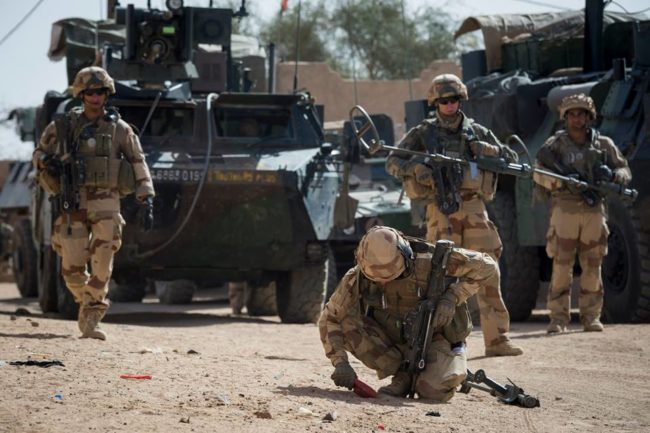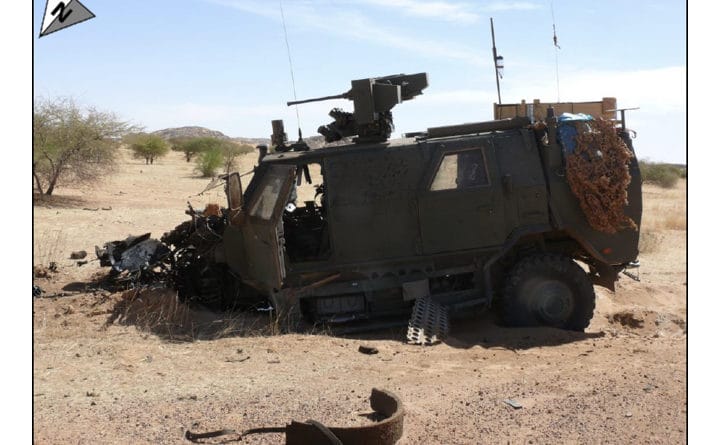IEDs, robust tools, continuous threat in the Sahel
(B2) With several deaths in Operation Barkhane, one after the other between the end of December and the beginning of January, the threat of mines and other improvised explosive devices appears to be growing. In fact, it is not.

A rather regular figure every year
« Every year, we discover, detect and prevent the detonation of more than XNUMX IEDs planted by terrorist groups says Colonel Barbry, spokesman for the army staff. This number is " roughly stable from one year to the next. " Every year, we deplore about ten attacks which do not all cause victims. "There is" no upsurge or pause » . The true " attacks peaked in 2015 ". Since then, he is actually " decreasing ».
Adding products to double the explosive effect
What changes instead is the valorization “Landed gear, with what is called” “Home made exclusive” (HME). In other words, the addition of chemical precursors or other products (eg nitrates, etc.) inside the device which increase the effect of the explosion. " Depending on the charge put, you get proportional damage with the materials put inside. “Since 2013, we have observed” the addition of Home made exclusive in IEDs ". The loads can be significant: up to 40 kg. Without automatically increasing the doses of explosives.
Proven local manufacturing
The IED systems used in Mali are “ basic and rudimentary ", usually " pressure ". The making " remains robust but relatively simple to place. But there is no improvisation. There are logistics centers “ producers "And" necessarily artificers » able to manufacture the IEDs on site.
An anti-IED device
The French have a fleet of 400 jammers, set up since the intervention in Afghanistan especially. " More than two thirds are deployed in particular in the Sahel. “These jammers set up a “ safety bubble "," particularly effective on RcIEDs », radio-controlled IED devices, triggered by a mobile phone for example (2). But they can do much less against explosive devices without remote control, in particular against PP-IEDs, triggered by pressure (the passage of a vehicle, for example). It is these pressure vessels that we mostly found in Mali and the Sahel in general.
Route openings
Faced with more rudimentary IEDs, it is the practice of reconnaissance by a route opening and protection detachment that is used with emblematic vehicles Buffalo (1) and Souvim (Mined Route Opening System) . " This minefield opening system allows you to travel about 150 km between 8 and 10 hours. That is a speed of progression of around ten km/h in the Sahel. Speed that may seem slow. But we are here" on rough and complicated abrasive terrain ».
Vital human intelligence
The problem is that machines can be posed after the passage of the reconnaissance vehicles. This requires armies to have a " certain organization » and especially to resort to « human intelligence " A " need " in " the hunt for security [...] in order to go up the chains, to locate the manufacturing centers, the logistic plots and those who implement them "...
(Nicolas Gros-Verheyde)
- A reinforced MRAP (Mine Resistant and Ambush Protected) wheeled armored military vehicle, built by Force Protection, a division of General Dynamics.
- The most recent of the systems, the so-called active-reactive 'Barrage' program with goniometry, is currently being deployed. It should eventually replace the other systems. Six 'Barrage' are already deployed in the Sahelo-Saharan strip (BSS in military terminology).
These answers were given to the various journalists present during the DICOD press briefing on 15.1, in which B2 participated (via audio conference).




Although it is slightly tangential, the expression IED displeases me supremely because on the one hand it is vulgarly American gibberish and on the other hand an inappropriate Western arrogance. Gibberish: Improvised Explosive Device. Device means everything and says nothing, trick, thing, thing, device, etc. Arrogance because Improvised implies that it was not thought out, and (alas) maturely mounted. Installers are not amateurs. Certainly they do not have the heavy Western structure with calls for tenders, approval of plans, manufactures, tests and the like, but they act with cunning. Finally, aping the Americans by taking their faults is not necessarily a positive sign. In short, of course we were not talking about artisanal mines.